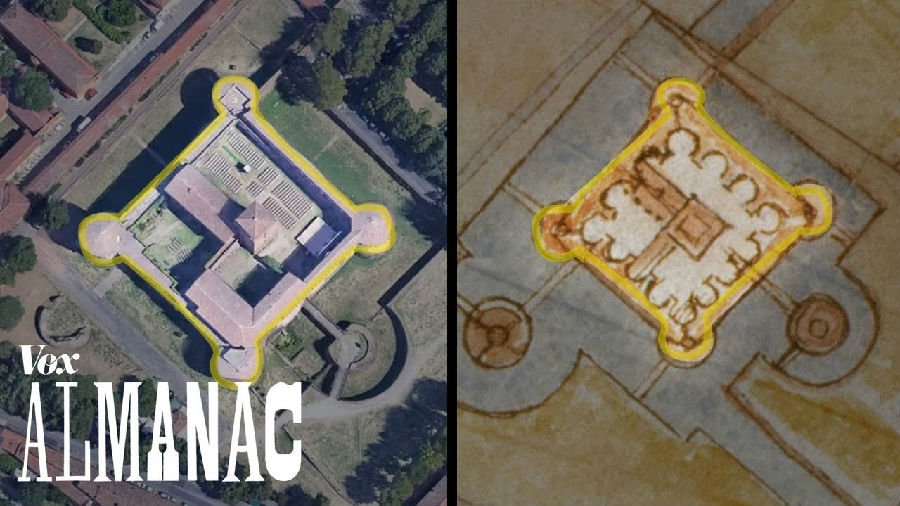This map from 2019 was compiled using satellite and aerial imagery.
这张2019年绘制的地图是用卫星和航空图像绘制而成的。
Leonardo da Vinci made this one around 1502 — while stuck on the ground. How?
而达芬奇在1502年左右就绘制出了这份地图,还是在不离开地面的情况下绘制出来的。他是怎么做到的呢?
When infamous Italian politician Cesare Borgia brought Leonardo da Vinci — the guy who drew this portrait — to the city of Imola, it was as a military engineer.
当声名狼藉的意大利政治家恺撒·博尔吉亚把列奥纳多·达·芬奇——就是画这幅画像的那个哥们儿——带到伊莫拉这座城市的时候,是以“军事工程师”的名义把他带过去的。
He’d already established a good military reputation — and painted several famous works.
那时,达芬奇已经是一位颇有名气的军事工程师了——还有了几幅著名的作品傍身。
When Leonardo was installed at Borgia’s newly acquired fort, one of his duties was to help Borgia learn the territory.
列奥纳多被安置在了博尔吉亚新夺取的一座城堡里,而他的职责之一就是帮助博尔吉亚了解这片领地。
At the time, a map like this one was the standard — a birdseye or hillside view.
当时,标准的地图是这种类型的——鸟瞰图或山顶视角图。
Mythical creatures often popped up — not great for military operations.
还会经常冒出来各种神话生物——这种地图就不太适合拿来指导军事行动了。
The perspective also only showed some buildings, blocking the view of other ones.
采用这种视角绘制的地图还只能显示部分建筑,其他建筑就被这些建筑挡住了。
These maps could be beautiful.
这些地图可能看着很漂亮。
But they lacked proper shape and scale and highlighted landmarks’ beauty at the expense of clarity.
但它们缺乏恰当的形状和比例,它们所突出的各个地标建筑的美也是以牺牲清晰度为代价的。
Leonardo needed to show Imola as an “ichnographic” map — an idea that Vitruvius — a Roman engineer and the guy who inspired this — had described.
列奥纳多要用“平面图”式的地图来展示伊莫拉这座城市,维特鲁威——罗马工程师,同时也是给了这幅画灵感的哥们儿——曾经提到过“平面图”式地图这个概念。
In practice, it’s a map where everything looks like you’re directly above whatever you show.
就实际操作而言,就是让地图上所有的东西看起来都像是你是它的正上方对它进行绘制的。
It gives you a clearer picture.
这样能给人们一个更清晰的印象。
Look at the fort.
就拿这个城堡来说。
In Google Maps, the shadow effects change a bit, but the fort’s perspective fundamentally stays the same.
在谷歌地图中,城堡的阴影效果稍稍发生了点儿变化,但是视角基本是保持不变的。
That’s similar to a real view from far above, where distance reduces the effects of shifting perspective.
跟在高空往下俯瞰——这时距离会减小视角变化的影响——时看到的情形是差不多的。

But Leonardo didn’t have a satellite to get up that far.
问题是,达芬奇没有能飞那么高的卫星啊。
His plan of Imola was a feat of symbolic imagination.
他绘制的伊莫拉地图完全是靠象征性的想象力完成的一次壮举。
And he had to make it accurate.
他还必须把它绘制地非常准确。
Based on sketches, previous work, and the design of his Imola map, we can guess at how Leonardo made it.
根据达芬奇的草图以及他之前的作品和伊莫拉地图的设计稿,我们基本可以猜出他是如何做到这一点的。
He probably used a type of disk that could measure degrees
他可能用到了一种可以测量度数的圆盘,
and had a little pointer to mark the angles of streets in relation to a stable point, usually North.
圆盘上还有一个小指针,用来标记街道和一个固定点,通常是代表正北方向的一个点,之间的夹角。
He probably used a compass to record the orientation of the town’s surrounding walls.
他可能有用指南针记录城镇周围墙壁的方位。
He did this at every turn, which helped him accurately translate the walls onto paper.
而且每个拐角处他可能都要测量,这能帮助他准确地把墙壁转移到纸面上。
Note the circular shape here, overlaid on the map.
注意覆盖在地图上的这个圆。
To establish scale, Leonardo also needed to measure the distance between all of these angles.
为了确定比例,达芬奇还需要测量所有这些角度之间的距离。
He probably paced this out by foot, or maybe using an odometer,
而那些距离他可能是用脚测量的,也可能是用里程表测量的,
with wheels that turned gears that measured distance by dropping a ball into a bucket at set intervals.
这种表内部的轮子能够带动齿轮,齿轮又能通过定时往桶里抛球测量距离。
With the angles and distance together, he could create a plan — hundreds of years before anyone could check if he got it right.
测量出了角度和距离,达芬奇便绘制出了这份地图,然而,要到数百年后,世人才有能力检验其准确性。
This stunning map from 1551, by another Leonardo, shows the potential Leonardo da Vinci’s method had.
这幅令人叹服的地图绘于1551年,绘制者也叫列奥纳多,这份地图显示出了达芬奇那种(地图绘制)方法的巨大潜力。
All these early ichnographic maps have asterisks -
所有这些早期的平面地图都带有星号——
this one was spotted with its own inaccuracies and artistic flourishes, a reflection of the scope of the project.
这幅地图有其自身的不准确性和艺术装饰元素,这些也反映了该项目的范畴。
In turn, Leonardo’s Imola had quibbles too — he probably used parts of previous surveys and other artistic techniques.
反过来,列奥纳多的伊莫拉地图也有其瑕疵——他可能参考了部分之前的调查以及其他的艺术技巧。
It also appears that he measured the town’s walls precisely, but took more liberties with the angles in the town’s interior.
此外,似乎他虽然精确地测量了那些城墙,但对城镇内部的那些夹角做了自由的调整。
But even with artistic license, this remains a map of more than a fort and town.
但即便是做了艺术的发挥,这幅地图也依然超越了一座城堡和一座城镇的地图这一属性。
It’s a transition from a geography of myth and perception to one about information, drawn plainly.
它也是从神话和直觉式地图过渡到信息式,直接明了地绘制的地图的分水岭。
It’s a map of Imola, but in the early 1500s, it was a map of the future, too.
它是一份伊莫拉的地图,但这份16世纪早期的地图也是一份未来式的地图。











